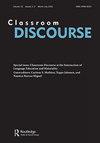Initiation and decision-making of joint activities within peer interaction in student-centred mathematics lessons
IF 1.6
Q2 EDUCATION & EDUCATIONAL RESEARCH
引用次数: 4
Abstract
ABSTRACT This study describes how students initiate and manage transitions between activities during group-work. Audio and video recordings were collected in secondary school mathematics lessons (6 x 75 min) based on student-centred learning and the idea of minimal teacher instruction. In these lessons, the students were given the responsibility to initiate and direct their own activities. Drawing on conversation analysis, the study focused on explicating a) two alternative initiating action formats: proposal and announcement, b) the co-participants’ responses and c) how these turns influence the nature of decision-making and subsequent group-work. The findings showed that joint activities were typically initiated through proposals formulated in interrogative or declarative construction. These equal ways of directing co-participants called for shared decision-making. If the proposal was followed by explicit or implicit resistance, the students used various verbal, embodied and material resources to engage the co-participant in negotiating and aligning with the proposed activity. Further, these sequences generally led to a collaborative working mode. By contrast, announcement was based on the initiator’s decision, and these sequences led to a guided working mode structured by the initiator. The findings extend our understanding of how a group of students coordinate transitions between activities.以学生为中心的数学课中同伴互动中联合活动的发起与决策
本研究描述了学生如何在小组工作中发起和管理活动之间的过渡。基于以学生为中心的学习和教师指导最少的理念,在中学数学课(6 x 75分钟)中收集了音频和视频记录。在这些课程中,学生们被赋予了发起和指导自己活动的责任。通过对话分析,本研究重点阐述了a)两种可选择的启动行动形式:提议和公告,b)共同参与者的反应,以及c)这些转变如何影响决策的性质和随后的小组工作。研究结果表明,联合活动通常是通过疑问句或陈述句结构提出的建议发起的。这些指导共同参与者的平等方式要求共同决策。如果提议之后有明确或隐含的抵制,学生们使用各种口头、具体和物质资源来吸引共同参与者进行谈判并与提议的活动保持一致。此外,这些序列通常导致协作工作模式。相比之下,公告是基于发起者的决定,这些序列导致由发起者构建的引导工作模式。这些发现扩展了我们对一群学生如何在活动之间协调过渡的理解。
本文章由计算机程序翻译,如有差异,请以英文原文为准。
求助全文
约1分钟内获得全文
求助全文

 求助内容:
求助内容: 应助结果提醒方式:
应助结果提醒方式:


